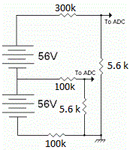ankitvirdi4
Member level 4
Hello Guys,
I have a simple application, there are 2 batteries connected in series as shown.
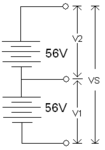
I want to measure the 3 voltages V1, V2 and VS individually. I will be using ADCs to to that, I have upto 6 ADCs.
Although making a simple resistor divider network and measuring V1 And VS using ADCs
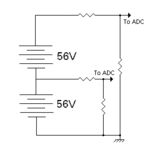
then calculating V2 in the microcontroller will meet my application needs.
But, I want to measure all 3 voltages, so basically I want 3 DC meters say mtr1 mtr2 and mtrS with range 0-60V, 0-60V and 0-120V respectively. This will give the application a certain flexibility. The user might wanna measure V1 using mtr2 and vice-versa. Or just use them as 3 individual DC meters.
The ideal way to do this is using differential amplifiers I guess similar to this.
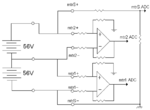
But, Say I don't want to use any opamps at all but just basic resistor divider?
I tried something like this.
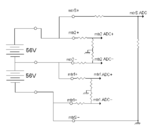
The problem here is , mtr1 ADC- and mtr2 ADC- will be negative voltages with respect to ground. ADCs of the microcontroller will not measure that.
So instead of grounding? Say we offset it by some voltage, 1.65V perhaps.
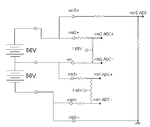
The problem here is 1.65 V to mtr1 and mtr2 ciruits must be isolated from each other, we'll need a buffer for that. That can be made using an opamp or a transistor and it will mostly solve the problem.
Is there any other method? Or another way of isolation? Or can implementing an inverter using an NPN transistor to invert negative voltages to the ADC work?
I have a simple application, there are 2 batteries connected in series as shown.

I want to measure the 3 voltages V1, V2 and VS individually. I will be using ADCs to to that, I have upto 6 ADCs.
Although making a simple resistor divider network and measuring V1 And VS using ADCs

then calculating V2 in the microcontroller will meet my application needs.
But, I want to measure all 3 voltages, so basically I want 3 DC meters say mtr1 mtr2 and mtrS with range 0-60V, 0-60V and 0-120V respectively. This will give the application a certain flexibility. The user might wanna measure V1 using mtr2 and vice-versa. Or just use them as 3 individual DC meters.
The ideal way to do this is using differential amplifiers I guess similar to this.

But, Say I don't want to use any opamps at all but just basic resistor divider?
I tried something like this.

The problem here is , mtr1 ADC- and mtr2 ADC- will be negative voltages with respect to ground. ADCs of the microcontroller will not measure that.
So instead of grounding? Say we offset it by some voltage, 1.65V perhaps.

The problem here is 1.65 V to mtr1 and mtr2 ciruits must be isolated from each other, we'll need a buffer for that. That can be made using an opamp or a transistor and it will mostly solve the problem.
Is there any other method? Or another way of isolation? Or can implementing an inverter using an NPN transistor to invert negative voltages to the ADC work?
